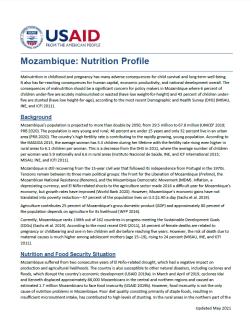Mozambique’s population is projected to more than double by 2050, from 29.5 million to 67.8 million (UNICEF 2019; PRB 2020). The population is very young and rural; 46 percent are under 15 years and only 32 percent live in an urban area (PRB 2020). The country’s high fertility rate is contributing to the rapidly growing, young population. According to the IMASIDA 2015, the average woman has 5.3 children during her lifetime with the fertility rate rising even higher in rural areas to 6.1 children per woman. This is a decrease from the DHS in 2011, where the average number of children per woman was 5.9 nationally and 6.6 in rural areas (Instituto Nacional de Saúde, INE, and ICF International 2015; MISAU, INE, and ICFI 2011).
Mozambique is still recovering from the 15-year civil war that followed its independence from Portugal in the 1970s. Tensions remain between its three main political groups: the Front for the Liberation of Mozambique (Frelimo), the Mozambican National Resistance (Renamo), and the Mozambique Democratic Movement (MDM). Inflation, a depreciating currency, and El Niño-related shocks to the agriculture sector made 2016 a difficult year for Mozambique’s economy, but growth rates have improved (World Bank 2020). However, Mozambique’s economic gains have not translated into poverty reduction—57 percent of the population lives on U.S.$1.90 a day (Sachs et al. 2019).
Agriculture contributes 25 percent of Mozambique’s gross domestic product (GDP) and approximately 80 percent of the population depends on agriculture for its livelihood (WFP 2016).
Currently, Mozambique ranks 136th out of 162 countries in progress meeting the Sustainable Development Goals (SDGs) (Sachs et al. 2019). According to the most recent DHS (2011), 14 percent of female deaths are related to pregnancy or childbearing and one in ten children will die before reaching five years. However, the risk of death due to maternal causes is much higher among adolescent mothers (age 15–19), rising to 24 percent (MISAU, INE, and ICFI 2011).

